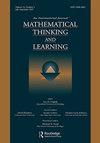战略知识重要吗?绘图策略知识对学生几何领域建模能力的影响
IF 1.5
4区 教育学
Q2 EDUCATION & EDUCATIONAL RESEARCH
引用次数: 2
摘要
摘要:我们调查了学生对情境(图画)绘画和数学(示意)绘画的策略知识如何影响几何领域的绘画准确性和建模能力。我们对473名九年级学生进行了一项前后测实验研究。学生被随机分配到三种治疗条件中的一种,在这种治疗条件下,我们使用90分钟的干预来促进关于情境绘画的战略知识(EG1)、关于数学绘画的策略知识(EG2)或关于情境和数学绘画的战略知识(EG3)。我们还使用了一个对照组,在这个对照组中,我们没有推广任何关于绘画(CG)的知识。多层次路径分析的结果并没有显示战略知识处理对学生建模能力的总体影响。然而,研究结果表明了一种间接影响:参与治疗的学生比对照组的学生表现出更高的建模能力,策略知识和绘图准确性是中介变量。此外,为建模问题构建更准确的情境或数学绘图的学生更有可能充分解决这个问题。我们的研究结果表明,战略知识是构建高质量图纸和高几何建模能力的必要但不充分的先决条件。本文章由计算机程序翻译,如有差异,请以英文原文为准。
Does strategic knowledge matter? Effects of strategic knowledge about drawing on students’ modeling competencies in the domain of geometry
ABSTRACT We investigated how students’ strategic knowledge about situational (pictorial) drawings and mathematical (schematic) drawings affects drawing accuracy and modeling competencies in the domain of geometry. We conducted a pre-posttest experimental study with 473 students in grade 9. Students were randomly assigned to one of three treatment conditions in which we used a 90-minute intervention to promote strategic knowledge about situational drawing (EG1), strategic knowledge about mathematical drawing (EG2), or strategic knowledge about situational and mathematical drawing (EG3). We also used a control group in which we did not promote any knowledge about drawing (CG). Results of a multilevel path analysis did not show a total effect of the strategic knowledge treatments on students’ modeling competencies. However, the results indicated an indirect effect: Students who participated in the treatments demonstrated higher modeling competencies than students in the control condition, and strategic knowledge and drawing accuracy were mediating variables. Moreover, students who constructed a more accurate situational or mathematical drawing for a modeling problem were more likely to solve this problem adequately. Our findings indicate that strategic knowledge is a necessary but not sufficient precondition for the construction of high-quality drawings and high modeling competencies in geometry.
求助全文
通过发布文献求助,成功后即可免费获取论文全文。
去求助
来源期刊

Mathematical Thinking and Learning
EDUCATION & EDUCATIONAL RESEARCH-
CiteScore
4.40
自引率
6.20%
发文量
18
 求助内容:
求助内容: 应助结果提醒方式:
应助结果提醒方式:


